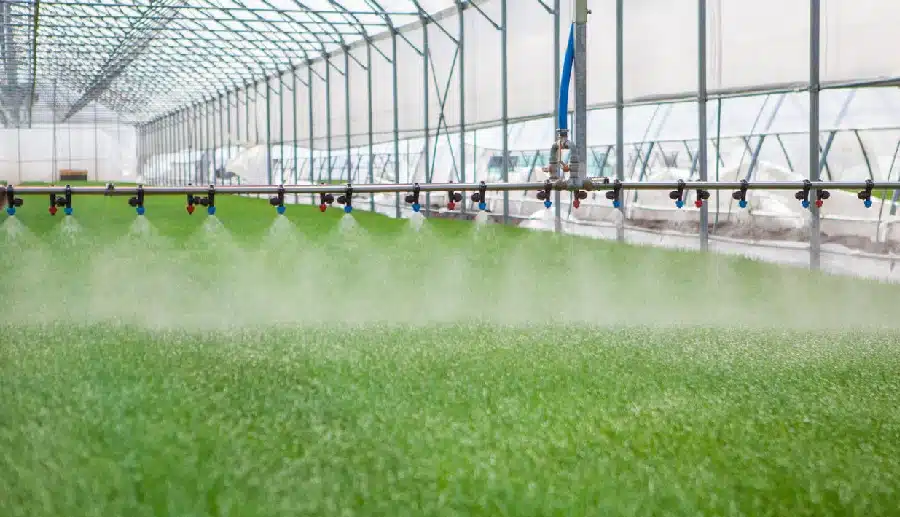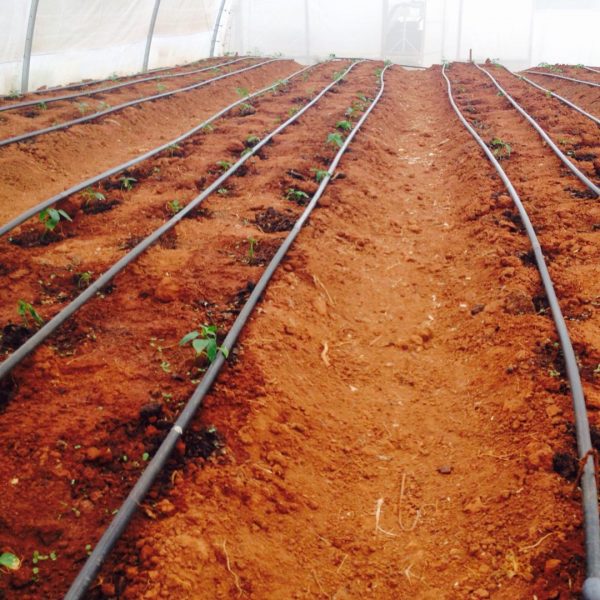Methods of irrigation under greenhouse condition
a. Hand water
- Most home greenhouses are watered by hand with a hose and suitable nozzle.
- Time to look at every plant and evaluate its condition is an advantage of hand watering.
- It is also easy to adjust the amount of water based on the needs of different plants.
- However, as greenhouse size and number of plants increase, hand watering becomes time-consuming compared with other methods.

b. Perimeter watering
- Perimeter watering system can be used for crop production in benches or beds.
- A typical system consists of aplastic pipe around the perimeter of a bench with nozzles that spray water over the substrate surface below the foliage
- Either polythene or PVC pipe can be used.
- While PVC pipe has the advantage of being very stationery, polythene pipe tends to roll if it is not anchored firmly to the side of the bench.
- This causes nozzles to rise or fall from proper orientation to the substrate surface.
- Nozzles are made of nylon or a hard plastic and are available to put out a spray are of 180°, 90° or 45°.Regardless of the types of nozzles used, they are staggered across the benches so that each nozzle projects out between two other nozzles on the opposite side. Perimeter watering systems with 180° nozzles require one water valve for benches up to 30.5 m in length.

c. Overhead sprinklers
- Sprinkler systems are relatively simple to install and convenient to operate.
- One drawback is that excess water must be applied; this makes up for water deflected by plant leaves and water that falls on areas where nothing is being grown.
- Also, wet foliage and higher humidity levels increase plant disease potential.
- A pipe is installed along the middle of a bed. Riser pipes are installed periodically to a height well above the final height of the crop.
- A total height of 0.6 m is sufficient for bedding plants flats and 1.8 m for fresh flowers.
- A nozzle is installed at the top of each riser.
- Nozzles vary from those that throw a 360° pattern continuously to types that rotate around a 360° circle.

d. Boom watering
- A boom system consists of one or more pipes containing nozzles that apply water as the system moves over the plants.
- It may be suspended from an overhead rail system or from a cart that moves down the aisle.
- Water is supplied by a trailing hose and powered by a battery pack or electric supply cable.
- A boom watering system generally consists of a water pipe boom that extends from one side of a greenhouse bay to the other.
- The pipe is fitted with nozzles that can spray either water or fertilizer solution down onto the crop. The boom is attached at its center point to a carriage that rides along rails, often suspended above the centre walk of the greenhouse bay. In this way, the boom can pass from one end of the bay to the other.
- The boom is propelled by an electric motor. The quantity of water delivered per unit area of plants is adjusted by the speed at which the boom travels.

e. Drip systems
- Drip irrigation systems might consist of individual capillary tubes for each pot or drip tape for ground beds.
- Drip irrigation uses water efficiently and keeps areas with no plants dry so that you can work around plants while they are being watered.
- Drip systems should be monitored to be sure they are maintained and working correctly to keep the water flowing from emitters.
- Drip systems are relatively easy to assemble, but they do take more time to set up than most of the other watering systems.
